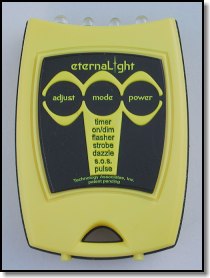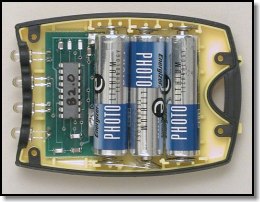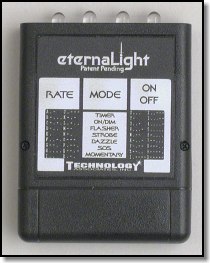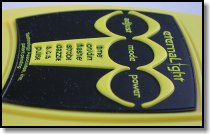

 |
 |
 The "eternaLight" three-AA-cell models from
Technology Associates take advantage of the solid state nature of LEDs to offer
some interesting capabilities, as well as a few silly ones. The microprocessor
based controller allows you to dim the LEDs electronically. They claim
"over 700 hours of burn time on one set of batteries," but there's a
catch, of course.� That's at this
four-LED light's lowest power setting, which uses a single LED at reduced
power. At its full power setting the alkaline batteries lasted 36 hours and the
lithium battery-powered model lasted 46.�
At the next lower power setting, which was nearly a bright, both lasted
almost twice as long.
The "eternaLight" three-AA-cell models from
Technology Associates take advantage of the solid state nature of LEDs to offer
some interesting capabilities, as well as a few silly ones. The microprocessor
based controller allows you to dim the LEDs electronically. They claim
"over 700 hours of burn time on one set of batteries," but there's a
catch, of course.� That's at this
four-LED light's lowest power setting, which uses a single LED at reduced
power. At its full power setting the alkaline batteries lasted 36 hours and the
lithium battery-powered model lasted 46.�
At the next lower power setting, which was nearly a bright, both lasted
almost twice as long.
Unlike virtually all the other conventional battery powered lights in this review, the eternaLights are flat and rectangular instead of a more conventional tube style.� This is one light that won't be rolling off the table.� (Prices on eternaLights updated 5/15/2002) The Model 3 "Ergo" ($40)� and translucent blue-cased Model 3X �ErgoXRay� ($50) are 3 5/8 x 2 9/16 x 7/8 inches and 3.5 oz., with the bright yellow-cased Model 3M "Ergo-Marine" ($55) being a half an ounce lighter due to the included lithium AA-cells, which also enable it to float, a nice feature. Exchanging the alkaline batteries for lithium in the other Ergo models will also enable them to float. The Ergos proved waterproof in our tests. The rounded body incorporates a large semi-circular lanyard hole.
 The Ergo is also offered with a pair of red or green LEDs
substituting for the outer pair of white LEDs, the RW and GW option,
respectively.� These are designed
primarily for those who are trying to protect their night vision, such as
pilots, sailors and astronomers. These are available only by special order (six
units minimum) in a variety of configurations. One supplier of these units is
Aeromedix.com which offers both models in the yellow ErgoMarine case with
lithium batteries (and who supplied samples for this evaluation).
The Ergo is also offered with a pair of red or green LEDs
substituting for the outer pair of white LEDs, the RW and GW option,
respectively.� These are designed
primarily for those who are trying to protect their night vision, such as
pilots, sailors and astronomers. These are available only by special order (six
units minimum) in a variety of configurations. One supplier of these units is
Aeromedix.com which offers both models in the yellow ErgoMarine case with
lithium batteries (and who supplied samples for this evaluation).
Despite having the LEDs aligned in a row, the actual beam is nicely converging at about eight inches and even, one of the best of the bunch.� With the RW and GW option, both the colored and white beams separately also converged well, as you would expect.� With these units you have a choice of colored light, white light, or all the LEDs lit.
 The red light is excellent, well diffused and even and the
brightness control (see below) allows the user the ability to provide only
enough light necessary for the task at hand, further preserving night vision
which can be adversely impacted by bright light, regardless of color.� The green LEDs unfortunately exhibit the
same annoying rings we've come to expect from all green LEDs we've seen.
The red light is excellent, well diffused and even and the
brightness control (see below) allows the user the ability to provide only
enough light necessary for the task at hand, further preserving night vision
which can be adversely impacted by bright light, regardless of color.� The green LEDs unfortunately exhibit the
same annoying rings we've come to expect from all green LEDs we've seen.
At full brightness, the light puts out plenty of useful light for most work and finding your way around and even at the minimum brightness level with the single LED it is just usable for close-up work, but not much else. The RW and GW models, with only a pair of white LEDs, were commensurately less bright, but equal to the best of the other dual LED models we tested. If both colored and white LEDs are selected on, there is a slight red or green cast to the white light, but it is brighter. The GW model, with green LEDs, appears brighter with both pairs of LEDs lit than the standard four-white LED model.
The various modes available include the default �timer� mode (an auto off mode to protect from inadvertent switching on of the light), the normal "on/dimmable" mode with 12 brightness settings;� "flasher," "strobe," and "dazzle," all three with variable rates; and "SOS" where it flashes an SOS signal.� There is also a momentary mode, for manual signaling use. It does take some experimenting and constant referral to the provided instructions to figure out all the available options at first, but once you understand how, getting to the exact mode and brightness you desire is very quick and soon becomes second nature.
 The XRay model has another potentially useful feature that
can be switched on or off, as desired. The �NightBeacon� illuminates the
translucent blue plastic body, either continuously or in a flashing mode. In
the continuous mode they claim it will operate for over a year, in flashing
mode for over 2 years (we cannot confirm that from our tests). As either a
nightlight or to find the flashlight easily in the dark, it's a surprisingly
useful option. The potential drawback is that you could turn on this feature
and forget it, running down the batteries.
The XRay model has another potentially useful feature that
can be switched on or off, as desired. The �NightBeacon� illuminates the
translucent blue plastic body, either continuously or in a flashing mode. In
the continuous mode they claim it will operate for over a year, in flashing
mode for over 2 years (we cannot confirm that from our tests). As either a
nightlight or to find the flashlight easily in the dark, it's a surprisingly
useful option. The potential drawback is that you could turn on this feature
and forget it, running down the batteries.
There is also the eternaLight �Classic� ($40) that incorporates the same LEDs and similatr circuitry in a plain black boxy plastic case, 3 x 2 1/4 x 3/4 inches and 4 oz. It functions pretty much the same as the Ergo models, but isn't as tough and isn't waterproof. A Morse code chart is attached below the buttons, which assumes anyone watching would know Morse code an unlikely scenario these days.� The boxy case allows the light to stand on its end, an occasionally useful capability.
 If these lights have a drawback, it is the switches.� These are pressure pad style, though with
excellent tactile feedback, and can be easily engaged when unintended. This was
exacerbated with the original version that had perfectly flat switching pads.
The latest versions have thicker rubberized switch pads with integrated raised
guards surrounding the switch, cutting down significantly on inadvertent
operation, a big improvement. They also make it much easier to work in the
dark, the guards providing more tactile feel for where the switches are
located.�
If these lights have a drawback, it is the switches.� These are pressure pad style, though with
excellent tactile feedback, and can be easily engaged when unintended. This was
exacerbated with the original version that had perfectly flat switching pads.
The latest versions have thicker rubberized switch pads with integrated raised
guards surrounding the switch, cutting down significantly on inadvertent
operation, a big improvement. They also make it much easier to work in the
dark, the guards providing more tactile feel for where the switches are
located.�
The default �timer� auto-off mode should protect you from dead batteries in most situations, so this isn't a serious problem. However, we'd suggest you plan to pack it very carefully if included in a survival kit or abandon ship bag to avoid problems.
Changing out the batteries is not something you're going to accomplish in the dark. The instructions warn that improperly installing the batteries can �permanently damage� the light, and it would be easy to do so.� It also requires a #0 Phillips screwdriver and you'd best not lose those tiny screws.
A couple other potential problems became evident when changing out the batteries. One, is that the batteries may stick to the foam rubber on the inside of the bottom case half that helps keep them in place and keeps them from rattling around. Two, the springs are glued in place and may come unglued from the case. These can be easily lost and it is, at best, an inconvenience getting them back in place to install the replacement batteries.
Technology Associates' lights are made in the U.S. and come with a lifetime limited� warranty.
For more information, check Craig Johnson's LED Museum
| LED Flashlight Review (click to continue to next page) |
|
| SELECT AND USE OUTDOORS AND SURVIVAL EQUIPMENT, SUPPLIES AND TECHNIQUES AT YOUR OWN RISK. Please review the full WARNING & DISCLAIMER about information on this site. |
Publisher and Editor: Doug Ritter
Email: Doug Ritter
URL:
http://www.equipped.org/led_lights5.htm
First Published: June 7, 2001
Revision: 02 May 15, 2002
![]()
Email to: [email protected]
|
© 2001-2002 Douglas S. Ritter & Equipped To Survive Foundation, Inc. All rights reserved. Check our Copyright Information page for additional information. |
Read the ETS Privacy Policy |